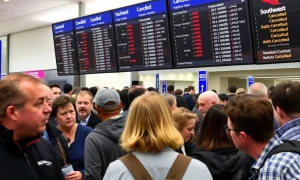The aviation sector frequently faces turbulence. For entrepreneurs and business leaders, understanding market shifts remains crucial. Recently, the prospect of a Spirit Airlines bankruptcy has emerged as a significant concern. This potential Chapter 7 filing could send ripples far beyond the airline’s immediate operations. Furthermore, it threatens to reshape the competitive landscape of air travel, affecting every single flier. This article delves into the profound implications of such a financial collapse.
Understanding Chapter 7: The Finality of Spirit Airlines Bankruptcy
Chapter 7 bankruptcy represents a complete liquidation of a company’s assets. For an airline, this means ceasing all operations. All flights stop. Planes are sold off. This differs significantly from Chapter 11, which allows for reorganization and continued business. Therefore, a Spirit Airlines bankruptcy under Chapter 7 would signify the end of the airline. This scenario would remove a major player from the ultra-low-cost carrier (ULCC) segment. Consequently, it would directly impact market dynamics.
Historically, airline bankruptcies have occurred. Each instance reshaped the industry. However, a Chapter 7 filing by a carrier of Spirit’s size would be particularly impactful today. This is due to the current consolidation in the U.S. airline market. Thus, fewer competitors exist now than in previous decades. This makes the loss of any major airline more acutely felt by consumers.
Reduced Competition: The Core Impact on Fliers
Spirit Airlines operates as a prominent ultra-low-cost carrier. Its business model focuses on offering highly competitive fares. This strategy forces other airlines to keep their prices lower. Consequently, Spirit’s presence benefits all travelers. It drives down costs across the board. The removal of Spirit from the market would immediately reduce competitive pressure. Furthermore, this would allow remaining airlines to increase fares. Consumers would face higher prices for flights, regardless of their preferred carrier.
Consider these key points regarding competition:
- Fewer Options: Travelers would have fewer choices for budget travel.
- Increased Fares: Remaining airlines could raise prices without fear of being undercut.
- Less Innovation: Reduced competition often leads to less pressure for service improvements.
This situation directly affects the average family. It also impacts business travelers. Travel budgets would stretch less far. Therefore, the ripple effect would extend throughout the economy.
Higher Fares and Fewer Routes: A Direct Consequence
A Spirit Airlines bankruptcy would undoubtedly lead to higher airfares. Spirit often provides the lowest price point on many routes. When this option disappears, other airlines face less pressure to offer competitive rates. Consequently, average ticket prices across the industry would likely climb. This affects not just former Spirit passengers but everyone. Legacy carriers and other budget airlines would have more pricing power. They could then charge more for their services.
Moreover, route availability would shrink. Spirit serves numerous smaller airports and niche routes. These might not be profitable for larger airlines. Thus, some destinations could lose direct service. Travelers would then face longer journeys or higher costs due to connecting flights. This diminishes convenience and increases travel time. Therefore, the overall accessibility of air travel could suffer. For instance, consider regional hubs that rely on Spirit for connectivity. Their options would become significantly limited.
Economic Ripple Effects: Beyond the Airline Industry
A Spirit Airlines bankruptcy extends its impact far beyond just ticket prices. Thousands of Spirit employees would lose their jobs. This includes pilots, flight attendants, mechanics, and ground staff. Their unemployment would strain local economies. Furthermore, suppliers to Spirit Airlines would suffer. These include catering companies, maintenance providers, and fuel suppliers. These businesses would lose a significant client. Some might face their own financial difficulties. Therefore, the economic fallout could be substantial.
Consider the broader implications:
- Job Losses: Direct and indirect job cuts across the aviation ecosystem.
- Supplier Distress: Businesses reliant on Spirit’s operations face revenue loss.
- Airport Impact: Airports would lose landing fees, gate rentals, and passenger revenue.
Local businesses near airports, such as restaurants and hotels, would also feel the pinch. Fewer flights mean fewer travelers. Fewer travelers mean less spending. Thus, the economic chain reaction is clear and far-reaching.
The Broader Aviation Landscape: Consolidation and Consumer Trust
The potential Spirit Airlines bankruptcy highlights a concerning trend in the U.S. airline industry: increasing consolidation. Fewer, larger airlines dominate the market. This reduces consumer choice and innovation. When a budget airline like Spirit exits, it further solidifies the power of the remaining giants. This makes it harder for new entrants to compete. Consequently, the market becomes less dynamic. This lack of dynamism can stifle service improvements and fare innovation.
Furthermore, consumer trust might erode. Frequent news of airline financial struggles can make travelers hesitant. They might worry about booking flights with smaller carriers. This uncertainty could push more travelers towards established, larger airlines. However, this further reduces competition. It creates a self-fulfilling prophecy of market consolidation. Therefore, the long-term health of a diverse and competitive airline industry faces significant challenges.
Future Outlook for Travelers: Navigating a Changed Sky
Travelers must prepare for a changed air travel landscape if Spirit Airlines bankruptcy occurs. The days of ultra-cheap flights might become less frequent. Consumers will need to adjust their travel budgets accordingly. Moreover, flexibility will become even more important. Route options could be limited. Booking further in advance might become necessary to secure reasonable fares. Therefore, proactive planning will be key for budget-conscious travelers.
The industry might also see a shift in how remaining airlines operate. They might absorb some of Spirit’s routes. However, they will likely do so at higher price points. They may also adapt their service models. This could include offering more basic economy fares. These fares mimic some ULCC characteristics but often come with more restrictions. Thus, the consumer experience could shift. It might become more standardized across carriers, potentially at a higher cost.
Preparing for the Inevitable: Advice for Fliers
While the prospect of a Spirit Airlines bankruptcy remains speculative, travelers can take steps. Always purchase travel insurance, especially for complex itineraries. This provides a safety net against unforeseen cancellations. Furthermore, consider booking directly with airlines. This simplifies refunds or rebooking processes if issues arise. Pay attention to airline news. Stay informed about potential disruptions. This proactive approach helps mitigate risks. It ensures a smoother travel experience. Thus, informed decisions empower travelers.
Additionally, travelers should diversify their airline choices. Do not rely solely on one carrier, even for frequent routes. Explore options from various airlines. Compare prices regularly. This practice helps maintain awareness of market conditions. It also ensures access to the best available fares. Consequently, it builds resilience against sudden market changes. This strategy benefits all fliers in an uncertain environment.
Conclusion: A Loss for All
A potential Spirit Airlines bankruptcy would represent a significant blow to the airline industry. More importantly, it would hurt all fliers. The loss of a major ultra-low-cost carrier would reduce competition. This would inevitably lead to higher fares and fewer route options. Furthermore, the economic ripple effects would extend far beyond the aviation sector. Job losses and supplier distress would impact communities. While the future remains uncertain, understanding these potential consequences is vital. Consumers and businesses alike must prepare for a potentially less competitive and more expensive air travel market. Thus, the importance of this development cannot be overstated.
Frequently Asked Questions (FAQs)
Q1: What does Chapter 7 bankruptcy mean for an airline like Spirit?
A Chapter 7 bankruptcy means the airline would cease all operations and liquidate its assets. It signifies the complete shutdown of the company, unlike Chapter 11, which allows for reorganization.
Q2: How would Spirit Airlines bankruptcy impact airfares for other airlines?
The removal of Spirit, a major low-cost competitor, would reduce competitive pressure. Other airlines would likely increase their fares, as they face less incentive to offer lower prices to attract customers.
Q3: Will a Spirit Airlines bankruptcy lead to fewer flight options?
Yes, Spirit serves many routes, including some smaller markets. If it ceases operations, these routes may no longer be served directly by other airlines, leading to fewer options and potentially more connecting flights for travelers.
Q4: What economic impact would a Spirit Airlines bankruptcy have beyond ticket prices?
Such a bankruptcy would result in significant job losses for Spirit employees. It would also negatively affect suppliers, airports, and local businesses dependent on air travel, creating broader economic ripple effects.
Q5: What should travelers do to prepare for potential airline disruptions?
Travelers should consider purchasing travel insurance, booking directly with airlines for easier management, and staying informed about airline news. Diversifying airline choices for routes can also provide flexibility.
Q6: Has a major U.S. airline ever filed for Chapter 7 bankruptcy before?
While many airlines have filed for Chapter 11 (reorganization), Chapter 7 liquidations are less common for major carriers. However, smaller airlines have ceased operations. A Chapter 7 for a carrier of Spirit’s size would be a significant event in modern aviation history.
























